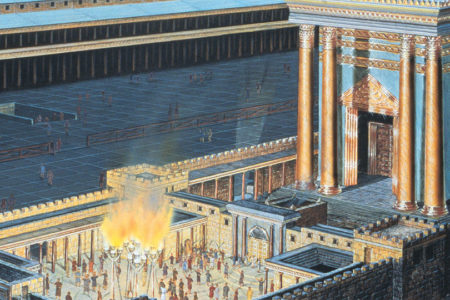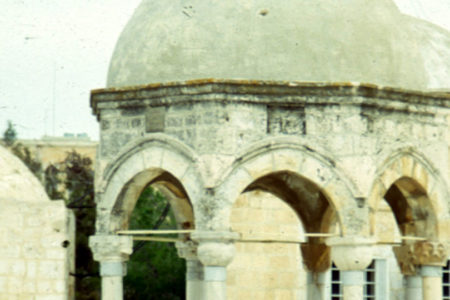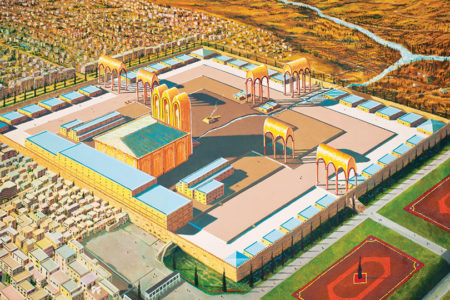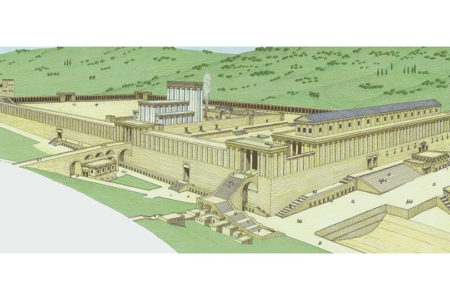Where Was Herod’s Temple?
New Evidence Questions Old Theories
Many Bible students are aware of the Old Testament Tabernacle, the portable sanctuary of the Lord described in graphic detail in Exodus 25-40. Fewer students however, have paid close attention to the Temple, the permanent sanctuary of the Lord described in 1 Kings 6–7 and 2 Chronicles 3–5. Yet this Temple, originally built by Solomon and rebuilt later by Zerubbabel and Herod, operated for a thousand years, over twice as long as the Tabernacle existed. Furthermore, the Temple was larger and far more elaborate than the Tabernacle.
Although a basic description of Solomon’s Temple is found in the Bible, it is difficult to reconstruct its architectural details. Also, there is no biblical description of the Second Temple, apart from a few references in the New Testament. We do, however, have an elaborate description of Herod’s Temple from the words of the Jewish historian, Flavius Josephus, and a rabbinic tractate in the Talmud entitled Middot. From these accounts scholars have been able to reconstruct in fairly precise detail how the Temple in New Testament times appeared to the Jewish pilgrims who often traveled thousands of miles to behold its beauty, concerning which the rabbis would often say, “He who has not seen Herod’s Temple has never seen a beautiful building.”*
A tremendous amount of archaeological work has been done around the Temple Mount since 1967. Unfortunately, no official digging has been done on the Temple Mount because it is a Moslem holy site housing the silver El Aksa mosque and the golden Dome of the Rock. Although there are many fascinating subjects associated with the Temple Mount, this brief article focuses on one controversial question: Where on the large esplanade was the exact location of the ancient Temple?
Until recently, that question would have been answered in but one way. Most scholars agreed that the Dome of the Rock, covering a large extrusion of limestone viewed by Moslems as the site of Muhammad’s “ascension,” is the site of either the Holy of Holies or the altar of sacrifice in the Temple. Primarily through the labors of a physics professor at the Hebrew University, however, that general consensus is being seriously questioned.
Asher Kaufman is an orthodox Jewish immigrant from Scotland who has long been interested in the topography of the Temple Mount. Through his own personal study of the Bible, the writings of Josephus, the rabbinic literature, and the Temple Mount itself, he has arrived at a startling conclusion: The ancient Temple was actually about a hundred yards north of the traditionally held location (i.e., the Dome of the Rock).
His ideas appeared about ten years ago in the Jerusalem Post and later in an in-depth article in the Biblical Archaeology Review.* The reader who would like to examine his various arguments should secure a copy of that magazine for further study. Following is a summary of some of Kaufman’s main points, with a cautious word about the implications of his theory.
The only gate that entered into the Temple area from the east is aptly called the Eastern Gate. It has been sealed since the late Middle Ages. Most scholars believe that it is built over the original Eastern Gate that led directly into the Temple courtyard. A reference in the Mishna reveals that, during the ceremony of the slaying of the red heifer (see Num. 19), the high priest could look from the top of the Mount of Olives directly over the Eastern Gate into the Temple sanctuary. This implies that the Temple building was directly behind the gate. This would not be the case, however, if the Temple were located on the site of the Dome of the Rock. If one could enter the sealed Eastern Gate today, he would have to make a left turn (south) to reach the Dome of the Rock.
If one marked a perpendicular line from the center of the Eastern Gate through the Temple Mount area, what would he encounter? Remarkably, that line would go directly through a small domed structure that covers a round, flat slab of Mount Moriah itself. That domed cupola is called, in Arabic, by either of two names: the Dome of the Spirits or the Dome of the Tablets.
Josephus and the rabbinic sources inform us that during the Second Temple period (516 B.C. to 70 A.D.), the Holy of Holies was actually empty. The ark had been removed before the destruction of the Temple in 587 B.C. In the Temples of Zerubbabel and Herod, the only thing in the Holy of Holies was the flat, bare rock of the mountain.
Could it be that this simple Moslem structure preserves an ancient idea that on the rock was the original ark containing the tablets of the Law engraved by the finger of God on Mount Sinai? Could it be that the Dome of the Spirits is the site of the Holy of Holies where the glory of God, called the Shekinah, dwelt in visible form (see 1 Ki. 8:10–11)?
While not all archaeologists have accepted Kaufman’s view, his arguments are based on more than just a few hunches. He is convinced that, if excavations could be allowed on this Moslem holy site (not very likely), the very foundations of the ancient Temple would be brought to light. A number of cisterns are located under this area that could have served as part of the extensive drainage system required for the sacrificial system of biblical times. The interested reader can study Kaufman’s other evidences in the article mentioned above.
While we should be cautious about being, overly dogmatic, certain implications of this theory should be mentioned. The Bible teaches in at least four places that a rebuilt Temple will exist during Daniel’s 70th week, sometimes referred to as the Tribulation period (see Dan. 9:26–27; Mt. 24:15; 2 Th. 2:4; Rev. 11:1–2). One of the biggest obstacles to any such reconstruction has always been the existence of the Dome of the Rock. If, however, a reconstructed Temple (perhaps even in the form of a temporary Tabernacle?) were built around the site of the Dome of the Tablets, no major Moslem structure would have to be removed.
This does not mean that the Moslems would ever approve of such a venture, but it does envision a possible scenario for the Antichrist’s maneuvers during those awful days that will follow the Rapture of the Church.
While there are some orthodox Jewish groups who would welcome an opportunity to begin construction of the third Temple, the Israeli government views with great concern the political ramifications of such a move. In the meantime, the rabbinical students who profess to be in the priestly line (the cohanim) quietly study the sacrificial laws, waiting for God to grant the opportunity to institute them once again.









Since the genealogical records were destroyed in AD 70 how can rabbinical students profess to be in the priestly line. With that in mind, won’t the actual priests in the coming temple be of the lineage of Zadok based on the prphecy of Ezekiel 44:15?